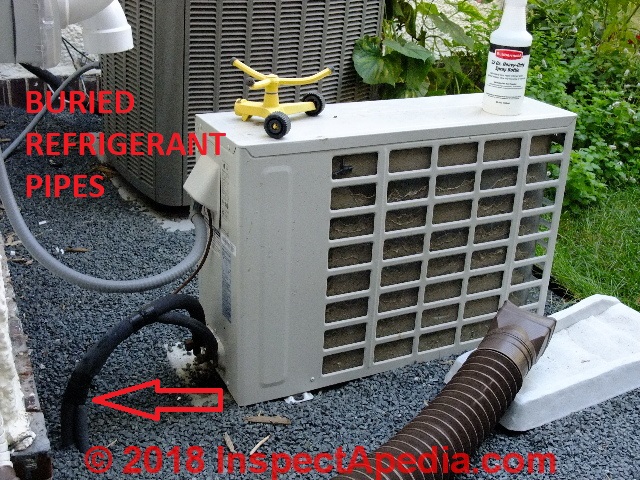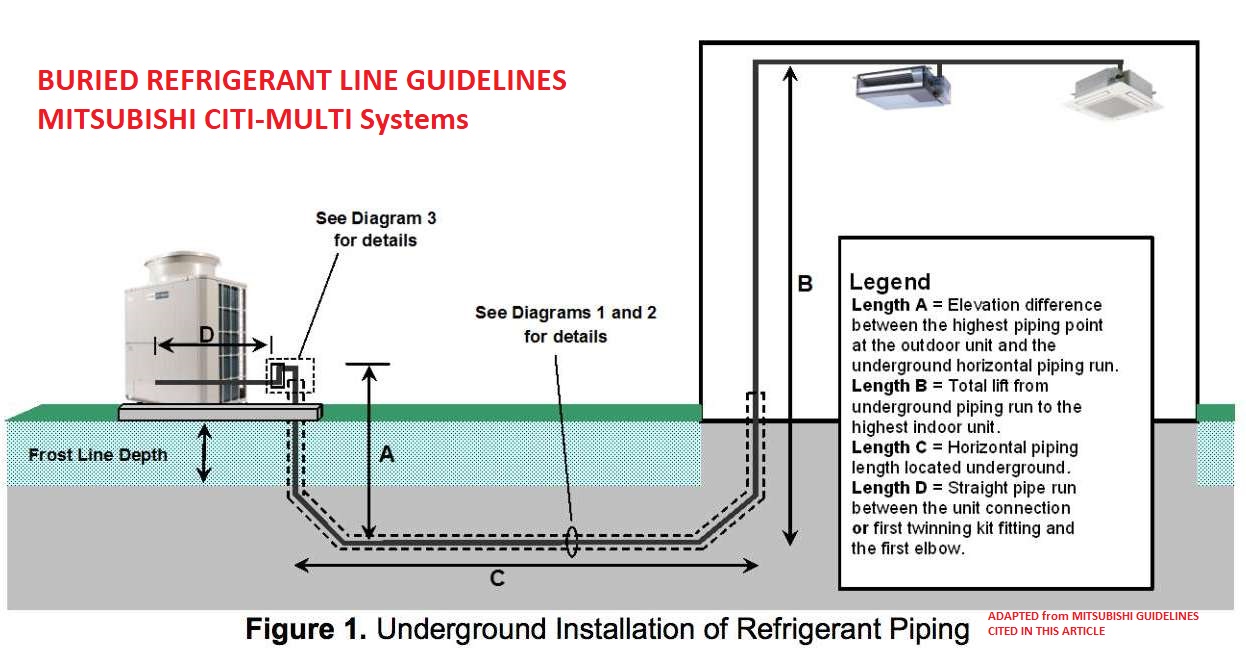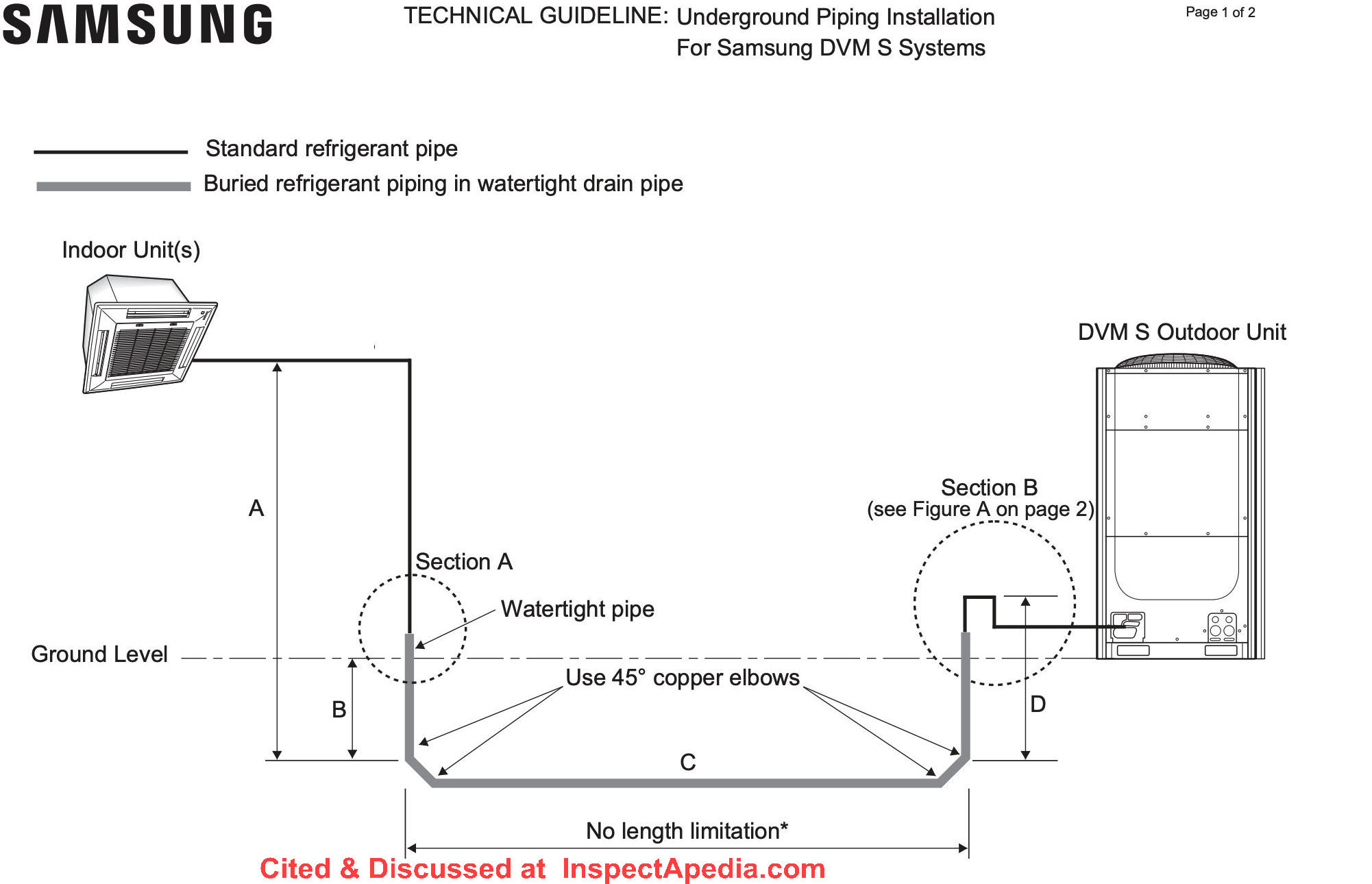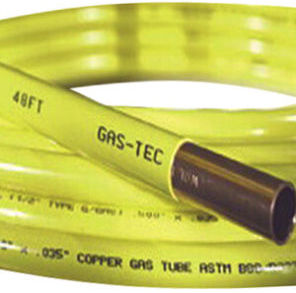 Buried Refrigerant Line Guidelines
Buried Refrigerant Line Guidelines
Underground Refrigerant Pipe Installation Procedures & Warnings
- POST a QUESTION or COMMENT about buried or underground HVAC system refrigerant piping or tubing routing, connections, materials, charging
Buried refrigeration equipment piping for air conditioners & heat pumps:
Is it permitted to route refrigeration tubing underground? If buried refrigeration lines are necessary, how should they be installed.
What problems occur when refrigerant tubing is run underground? Here we provide guidelines for underground / buried refrigerant lines from every major HVAC manufacturer.
Page top photo: refrigerant pipes routed underground at a Minneapolis home. Note the absence of appropriate protection around these refrigerant lines.
InspectAPedia tolerates no conflicts of interest. We have no relationship with advertisers, products, or services discussed at this website.
- Daniel Friedman, Publisher/Editor/Author - See WHO ARE WE?
Underground or Buried HVACR Refrigerant Line Installation
 These refrigerant line piping questions and answers about buried or underground routing were posted originally
These refrigerant line piping questions and answers about buried or underground routing were posted originally
at REFRIGERANT PIPING INSTALLATION - be sure to see the advice and installation standards for refrigerant line piping given there.
Circled in our photo just above is another refrigerant line that was simply buried with its foam insulating jacket. As you'll read below in our excepts from buried refrigerant line guidelines from just about every major HVAC manufacturer, that's not the best practice to follow.
Article Contents
- AVOID BURYING REFRIGERANT PIPING if POSSIBLE
- REFRIGERANT PIPING BURIAL GUIDE from Johnson Controls
- REFRIGERANT PIPING BURIAL GUIDE from Lennox
- REFRIGERANT PIPING BURIAL GUIDE from Mitsubishi
- REFRIGERANT PIPING BURIAL GUIDE from Puron
- REFRIGERANT PIPING BURIAL GUIDE from Samsung
- REFRIGERANT PIPING BURIAL GUIDE from Trane
- ADDITIONAL STEPS to AVOID COMPRESSOR FLOODBACK from buried refrigerant lines
- REFERENCES, STANDARDS, GUIDELINES for BURIED REFRIGERANT LINES
- SOURCE of CONDUIT for BURIED REFRIGERANT LINES
- PROTECTIVE COVERS for REFRIGERANT LINES run on building Exterior Walls
...
What's wrong with running AC piping underground?
Our reader asked: During the home inspection of the 1-year-old house, the inspector pointing out the AC piping lose, improperly run/buried, find attached the picture [shown just above] please advise if anything wrong with that or not and if it's not right what needed to be done. - Kash
Answer: There is a liquid slugging risk with underground / buried refrigerant piping
Buried or underground refrigerant piping on residential HVAC systems is not recommended, but at least for some manufacturers and building codes, underground refrigerant distribution piping is not expressly prohibited, but where used it must be properly installed, protected,& insulated.
Your refrigerant lines are not adequately protected and is not installed in keeping with the manfacturer's recommendations in that I see no protective piping or sleeve, just insulation. Kudos to your home inspector. - Daniel F.
- Refrigerant floodback:
The first concern with underground refrigerant piping, particularly the suction line, is that running refrigerant piping underground invites the accumulation of liquid refrigerant in the return or suction line.
Where the refrigerant lines are underground and cooled by that location, the suction line may accumulate liquid refrigerant.
Subsequently at the next compressor on-cycle the return of liquid refrigerant in the suction line can cause liquid slugging at the compressor motor. That in turn destroys the compressor. - Refrigerant line corrosion & leaks:
The second concern with un-protected underground refrigerant piping is that of corrosion. Copper refrigerant piping left unprotected underground is exposed to corrosion and leaks. - Liquid slugging can destroy the compressor motor:
At REFRIGERANT FLOODBACK, LIQUID SLUGGING we explain how liquid refrigerant entering a heat pump or air conditioner compressor motor can destroy it and we discuss the recommended time that the system should be LEFT OFF if was switched off while it was running
Underground Refrigerant Piping Instructions for Burial from HVAC Manufacturers
Johnson Controls Statement on Underground Refrigerant Piping
Here is what Johnson Controls advises where refrigerant piping must be buried:
Use PVC piping as a conduit for all underground installations.
See the illustration below, adapted from Johnson Controls' Application Data Sheet cited also below.
Watch out: Buried lines must be kept as short as possible to minimize the build up of liquid refrigerant in the vapor line during long periods of shutdown.
...
Lennox statement on underground refrigerant piping:
Refrigeration lines must not be buried in the ground unless they are insulated and waterproofed. Uninsulated copper lines buried in wet soil or under concrete can cause serious capacity loss and erratic operation as well as early failure due to corrosion.
Systems with buried refrigerant lines can experience significant or total capacity loss if allowed to transmit heat to the surroundings. In addition, buried lines are susceptible to corrosion which can shorten the life of the system.
For this reason, buried lines must rest inside a sealed, watertight, thermally insulated conduit. The lines must not contact the soil for any reason and the conduit must be designed so it cannot collect and retain water.
I will add this and other citations in the article above. We can't know from just your photo how much buried piping is installed at the home in your photo nor exactly where it is routed.
It MIGHT be that the only buried piping is vertical and that in this specific instance it's not damaging the compressor - but the possibility is certainly there.
The refrigerant piping in your photograph is not following the industry-recommended best-practice and could risk damage to the compressor motor.
Watch out: some HVACR manufacturers explicitly prohibit routing refrigerant distribution piping underground for commercial systems. (Carrier Corporation, McQuay corporation & Trane Corporation). And even where buried refrigerant distribution lines are permitted, that installation may not be a recommended practice.
...
Mitsubishi Guidelines on Installing Buried Refrigerant Piping
Refrigerant lines must be installed below the frost line. The depth required past the frost line depends on the amount of foot or vehicle traffic that may pass over the refrigerant line path.
[Click to enlarge any image]
Include the sum of Lengths A and B (see Figure 1) in the calculation for maximum vertical lift for the respective unit. See the System Design Section in the Engineering Manual(s) to obtain the maximum allowable vertical lift.
For Length C, there is no limitation other than the standard piping line length guidelines.
Length D must be a minimum of 20 inches.
Use 45° elbows to simplify covering the refrigerant lines with casing. For refrigerant piping with outside diameters of up to 3/4″, soft tubing can be used and large sweeping curves can be bent by hand.
Refrigerant lines must be insulated separately. A minimum of 1/2" thick insulation is required. If possible, install casing as one continuous piece.
If the casing includes joints, contact the casing manufacturer for instructions on how to make them watertight. Flexible watertight drain line is recommended. DO NOT USE flexible perforated drain pipe [to route refrigerant piping] - Mitsubishi guidelines for underground installation of CITY MULTI R2-series and Y-series and S-series refrigerant piping, cited below.
...
Puron statement on Long Lines, Buried Lines, Refrigerant Migration & Elevation Changes in Refrigerant Lines
Longer line sets require additional refrigerant charge that must be managed throughout the entire range of possible ambient conditions. Off--cycle refrigerant migration that results in excess refrigerant in the compressor at start up, or condensed liquid refrigerant in the suction line at start up must be avoided for compressor reliability.
Follow all accessory requirements in this Guideline to control off--cycle refrigerant migration (see Table 1).
Another concern is proper line set sizing and construction to control oil return to the compressor, and minimize capacity losses. In residential applications, proper suction line sizing is critical to achieve adequate oil return, and maintain expected system performance.
Oil return in heating mode is different from cooling mode thus, in some cases, heat pumps have additional line set limitations from air conditioning units. ...
The third concern is refrigerant metering. Elevation changes affect pressure drop in refrigerant lines. These effects must be considered when sizing liquid lines and orifice--metering devices. - Puron, Residential Piping & Long Line Guideline, cited below
...
Samsung statement on Long Lines, Buried Lines, Refrigerant Migration & Elevation Changes in Refrigerant Lines
All buried refrigerant pipes and communication wires must be installed in a watertight, underground drain pipe.
The open ends of the watertight pipe must be sealed at the ends to prevent water and debris from entering.
Entry of water will impact system efficiency and can cause damage to the equipment.
- Samsung, "Buried Refrigerant Piping Guide", cited and included as a PDF download below.
...
Trane Statements on Underground Refrigerant Lines
Avoid putting refrigerant lines underground. Refrigerant condensation or installation debris inside the line, service access, and abrasion/corrosion can quickly impair reliability.
Any heat that transfers from the surrounding air to the cooler suction lines increases the load on the condenser (reducing the system’s air-conditioning capacity) and promotes condensate formation. After operating the system and testing all fittings and joints to verify that the system is leak-free, insulate suction lines to prevent heat gain and unwanted condensation.
- Trane, "Tube Size and Component Selection for RAUC Split Systems (20–120 Tons)" cited below.
It is advisable to avoid running refrigerant lines undergroundw henever possible. If it is absolutely necessary to run refrigerant lines underground, they must be run in 6" P.V.C. conduit.
Use 45° elbows to facilitate pulling the tubing through the conduit. The purpose of the conduit is to keep water away from the refrigerant lines. Careful sealing, where the lines enter and leave the conduit is critical. Some installers install a drain in the lower parts of the conduit.
Bear in mind, that if the water table rises above the drain, water may be forced into the conduit. Vapor and liquid lines must be insulated inside the underground chase. - Trane, Refrigerant Piping Manual for Small Split Cooling & Heat Pump Systems - cited below.
...
Additional Steps to Protect the Compressor from Flood-Back Refrigerant where Lines are Underground
OPINION: even where buried/underground refrigerant lines have been installed following best-practices there are additional practices that can protect the compressor from liquid floodback damage. From my reading it's not clear that these measures are needed if your buried refrigerant piping follows the manufacturer's instructions.
- Re-route refrigerant piping above ground where possible
- Design the HVACR controls to include a pumpdown sequence cycle at the end of a cooling cycle, removing more refrigerant from the suction side.
- Install a suction accumulator in the condenser unit ahead of the compressor motor
- Use a hard--shutoff TXV for metering in the cooling mode. This provides adequate refrigerant migration protection for all cooling applications. [Puron]
- Use a liquid-line solenoid to positively shut off refrigerant flow for single state and two-state heat pump systems. [Puron]
More information about various causes of refrigerant flood-back into the compressor is at REFRIGERANT FLOODBACK CAUSES.
...
Buried & Other Refrigerant Piping Sources, Codes, References, Standards
- Allied, REFRIGERANT PIPING DESIGN FABRICATION GUIDELINES [PDF] (2011) Allied Commercial A/C, Retrieved 2021/04/11 original source: https://pascalliedcdnep.azureedge.net/ alliedcommercial/T-Series_Ref_Pipet_Guidelines.pdf
- ASHRAE Handbook, Refrigeration, Chapter 2, 2006. © American Society of Heating, Refrigerating and Air-Conditioning Engineers, Inc., www.ashrae.org.
- California: CALIFORNIA MECHANICAL CODE, CHAPTER 11, CMC (2010), [PDF] IAPMO, retrieved 2018/03/13 original source: http://www.iapmo.org/California%20Mechanical%20Code/Chapter%2011.pdf
Excerpt:
1111.6 Underground Piping. Refrigerant piping placed underground shall be protected against corrosion. - Copper.org INSTALLATION of UNDERGROUND COPPER PIPING [PDF] (2010) Copper Development Assoc., Inc., Retrieved 2021/04/11 original source: https://www.copper.org/applications/plumbing/water_service/installation.html
Note: focused on buried water lines not refrigerant piping, this trade publication is useful for detailed description of copper pipe preparation and burial; it does not specifically cite refrigerant piping requirements;
The publication includes detailed suggestions for waterproofing the sleeving used to protect buried pipes, beginning with:
Excerpt: When sleeving is required, it is very important that the sleeve be sealed water-tight against the infiltration of ground water.
Failure to seal the sleeve can result in the collection and concentration of ground water contaminated with thawing salts, fertilizers or other chemicals around the tube surface, which can cause corrosion of the tube. - Daiken, REFRIGERANT PIPING DESIGN GUIDE [PDF] (2019) AG-31-01, (78 page manual), Daiken AC (Americas), Inc., 1645 Wallace Dr. Suite 110, Carrolton TX 75006 USA Email: info@daikinac.com Website: www.daikinac.com
- Daiken, R410A VRV INSTALLATION (2007) Daiken AC (Americas), Inc., 1645 Wallace Dr. Suite 110, Carrolton TX 75006 USA Email: info@daikinac.com Website: www.daikinac.com VRV-Installation-Guide-Daiken.pdf
- Johnson Controls, GENERAL PIPING RECOMMENDATIONS AND REFRIGERANT LINE Length for Split-System Air Conditioners and Heat Pumps" - Application Data Sheet [PDF] (2009) Johnson Controls Unitary Products, 5005 York Drive Norman, OK 73069 USA, Website: http://www.johnsoncontrols.com/, officesd world-wide, retrieved 2018/03/12, original source: http://www.usair-eng.com/pdfs/long-line-piping.pdf
- Lennox, LENNOX REFRIGERANT PIPING DESIGN & FABRICATION GUIDELINES, [PDF] (2008), retrieved 2018.03/12, original source: http://www.mechanicalconceptsllc.com/downloads/Refrigerant%20Piping%20Manual.pdf
- Mitsubishi, UNDERGROUND INSTALLATION of CITY MULTI® R2-Series, Y-Series & S-Series Refrigerant Piping, [PDF] (2002 & 2013), Mitsubishi Electric, retrieved 2018/03/13, original source: http://meus1.mylinkdrive.com/files/ Application_Note_2002_-_Buried_Refriegerant_Lines.pdf
- Althouse, AD, MODERN REFIRGERATION & AIR CONDITIONING [Book Review] A. D. Althouse, C.H. Turnquist, A. Bracciano, Goodheart-Willcox Co., 1982
- Marsh, RW, PRINCIPLES of REFRIGERATION [Book Review] R. Warren Marsh, C. Thomas Olivo, Delmar Publishers, 1979
- McQuay, REFRIGERANT PIPING GUIDE [PDF] AG31-011 McQuay Corporation, Americans HQ: 13600 Industrial Park Blvd., Minneapolis, Minnesota 55441, 800-432-1342 (Toll Free) 763-553-5330 (Direct), 763-553-5177 (Fax). Web search 07/15/2010 original source: http://www.mcquay.com/mcquaybiz/literature/ lit_systems/AppGuide/AG_31-011_120407.pdf - q
Excerpts:
Piping should also be protected from mechanical damage.
Where piping is exposed to possible damage, the lines should be routed out of the way or be protected in some form of chase.
Burying refrigerant lines should be avoided.
McQuay International delivers engineered, flexible solutions for commercial, industrial and institutional HVAC requirements with reliable products, knowledgeable applications expertise and responsive support.
As part of Daikin Industries, a Fortune 1000 company, McQuay is the second largest air conditioning, heating, ventilating and refrigeration company in the world. - Puron, RESIDENTIAL [REFRIGERANT] PIPING & LONG LINE GUIDELINE [PDF] (2009), Puron Corp., 7310 W. Morris St. S Indianapolis, IN 46231 USA
- Samsung, BURIED REFRIGERANT PIPING GUIDE from Samsung [PDF] - retrieved 2025/04/17, original source: www.samsunghvac.com
- Trane, REFRIGERANT PIPING REQUIREMENTS [PDF] Trane corporation, Air Conditioning Clinic, Refrigerant Piping Manual,
Excerpt:
The focus of this clinic is on the design and installation of the interconnecting piping for vapor-compression refrigeration systems.
Reviewing the physical changes that the refrigerant undergoes within the refrigeration cycle will help demonstrate certain demands that the piping design must meet.
This clinic focuses on systems that use Refrigerant-22 (R-22). While the general requirements are the same for systems that use other refrigerants, velocities and pressure drops will differ. - Trane, REFRIGERANT PIPING MANUAL for SMALL SPLIT COOLING & HEAT PUMP SYSTEMS [PDF] (2011), Trane Corporation, retrieved 2018/03/13, original source: http://www. ductwork installation .com/ portals/0/ss-apg006-en.pdf
- Trane, REFRIGERANT TUBE SIZE & COMPONENT SELECTION for RAUC Split Systems (20–120 Tons) Application Guide [PDF] (2001), Trane Corporation, Website: http://www.trane.com/, retrieved 2018/03/13, original source: http://www.trane.com/ Commercial/Uploads/Pdf/1109/large%20splits%20-%20 marketing%20guide%20tube%20size.pdf
- Whitman WC, Refrigeration and Air Conditioning Technology [Book recommendation] 5th Ed., [Book Review] William C. Whitman, William M. Johnson, John Tomczyk, Cengage Learning, 2005, ISBN 1401837654, 9781401837655 1324 pages
- York, REFRIGERANT PIPING APPLICATION DATA SHEET [PDF] (2016) General Piping Recommendations and Refrigerant Line Length for Split-System Air Conditioners and Heat Pumps, Johnson Unitary Controls, York International Corporation 5005 York Drive Norman, OK 73069, retrieved 2021/04/11 original source: .usair-eng.com/pdfs/long-line-piping.pdf
Excerpts:
The tables and application data in this publication will help you to better apply split-system cooling and heat pump systems to achieve maximum efficiency and performance, improved reliability, and greater customer satisfaction. This guideline includes information for:
General Guidelines
Indoor Unit Above the Outdoor Unit
Outdoor Unit Above the Indoor Unit •
Total line length
Line Sizing
Additional Refrigerant
Refrigerant Oil Management
Accumulator Use and Misuse
Recommended Orifice Sizing Chart •
Long Line Set Applications
...
Where to buy 4" diameter conduit / sleeve to bury copper refrigerant piping?
An InspectApedia reader asked:
Where can I buy flexible 4-inch sleeve to bury copper refrigeration piping? On 2021-04-11 by Dan Medler
by (mod) - to protect buried refrigerant lines, use standard PVC piping + insulation & make it water tight
@Dan Medler,
Bottom line: you should be able to use standard PVC pipe tubing and elbows of sufficient diameter to contain your refrigerant lines (including the recommended insulation on the vapor line) though as you'll read on this page it's preferable to avoid burying refrigerant piping.If you must bury your refrigerant tubing, keep the runs as short as possible and be sure that your PVC used as conduit is water tight throughout its route.
Details:
I can see why you're asking because doing my own search I couldn't find a 4 inch diameter conduit sold specifically for the purpose of installing buried air-conditioning or heat pump refrigerant lines.
Samsung's illustration above seems to be using copper pipes and elbows to protect the underground refrigerant line.
For example this BURIED REFRIGERANT PIPING GUIDE from Samsung [PDF] Original source: www.samsunghvac.com states:
All buried refrigerant pipes and communication wires must be installed in a watertight, underground drain pipe.The open ends of the watertight pipe must be sealed at the ends to prevent water and debris from entering.
Entry of water will impact system efficiency and can cause damage to the equipment.
But above on this page at the Johnson Controls statement on buried refrigerant piping the company's illustration (edited for clarity by us) shows using common PVC piping to provide an underground conduit. It's not a product made just for burying refrigerant lines.
And as I show below, expert sources of refrigerant piping system information such as Lennox include standard PVC piping at their own website pages [Web pabge, retrieved 2025/04/17] on refrigerant line supplies.
You should keep such runs short to avoid accumulation of refrigerant in the buried section when the system is turned off; details are in the article above. That length recommendation remains even though the Samsung document I cited above states in their illustration "no length limitation" Samsung also warns "*Do not exceed standard pipe length limitations".
I have added some additional refrigrant piping installation manuals and guides to those offered near the end of the article above - do take a look.
Watch out: don't get confused by PBC coated copper tubing rated for use with gas fuels but not necessarily approved for refrigerant applications, we show here in our photo of the Kamco yellow plastic-coated "copper gas tube" example from Gas-Tech. This Kamco Gas-Tec product is sold for use in LNG or LP fuel gas piping installations.
...
Line set covers for refrigerant piping for a heat pump run down a building wall
An InspectApedia reader asked: Where can I find the plastic covers for my heat pump lines that run on an exposed wall.?
Reply: search for HVAC refrigerant line set covers by any of these manufacturers:
Your local HVAC supplier carries piping covers and insulation.
You may also find these products at building suppliers such as Loews or Home Depot.
It's very common to see insulated refrigerant tubing that is further protected by a simple metal or plastic downspout.
Several companies provide decorative PVC covers for refrigerant tubing that you'll find sold online and at building suppliers such as Lowes or Home Depot, including line cover kits from
- Airex
- Cestluck
- DiversiTech
- Febtech
- Pioneer
- KUAFU
- LBG
- MrCool
- Ramsond
- RectorSeal
- Senville
- Vevor
- Weetall
...
Thank you to our readers for their generous comments
Thank you so much to sharing this very helpful article. - On 2020-09-15 by gilsulate
...
...
Continue reading at REFRIGERANT PIPING INSTALLATION - topic home, or select a topic from the closely-related articles below, or see the complete ARTICLE INDEX.
Or see these
Recommended Articles
- REFRIGERANT DRIERS & FILTERS
- REFRIGERANT GASES & PIPING - home
- REFRIGERANT PIPING INSTALLATION
- REFRIGERANT PIPING DAMAGE & LEAKS
- REFRIGERANT PIPING GURGLING
- REFRIGERANT PIPING INSULATION
- REFRIGERANT LINE MOUNTING
- REFRIGERANT LINE NAIL PROTECTION
- REFRIGERANT PIPING LENGTH vs DIAMETER
- REFRIGERANT TUBING BRAZING & SOLDERING
- REFRIGERANT TUBING FLARE CONNECTIONS
- REFRIGERANT TUBING ECONOMIZER & HEATING TRICKS
- REFRIGERANT PIPING UNDERGROUND, BURIED
- REFRIGERANT PIPING CODES & STANDARDS
- REFRIGERANT PRESSURE DIAGNOSIS
Suggested citation for this web page
REFRIGERANT PIPING UNDERGROUND, BURIED at InspectApedia.com - online encyclopedia of building & environmental inspection, testing, diagnosis, repair, & problem prevention advice.
Or see this
INDEX to RELATED ARTICLES: ARTICLE INDEX to AIR CONDITIONING & HEAT PUMPS
Or use the SEARCH BOX found below to Ask a Question or Search InspectApedia
Ask a Question or Search InspectApedia
Try the search box just below, or if you prefer, post a question or comment in the Comments box below and we will respond promptly.
Search the InspectApedia website
Note: appearance of your Comment below may be delayed: if your comment contains an image, photograph, web link, or text that looks to the software as if it might be a web link, your posting will appear after it has been approved by a moderator. Apologies for the delay.
Only one image can be added per comment but you can post as many comments, and therefore images, as you like.
You will not receive a notification when a response to your question has been posted.
Please bookmark this page to make it easy for you to check back for our response.
IF above you see "Comment Form is loading comments..." then COMMENT BOX - countable.ca / bawkbox.com IS NOT WORKING.
In any case you are welcome to send an email directly to us at InspectApedia.com at editor@inspectApedia.com
We'll reply to you directly. Please help us help you by noting, in your email, the URL of the InspectApedia page where you wanted to comment.
Citations & References
In addition to any citations in the article above, a full list is available on request.
- Thanks to reader Anon. for discussing the allowable distance between air conditioner compressor and a building or from the air handler - July 2010
- In addition to citations & references found in this article, see the research citations given at the end of the related articles found at our suggested
CONTINUE READING or RECOMMENDED ARTICLES.
- Carson, Dunlop & Associates Ltd., 120 Carlton Street Suite 407, Toronto ON M5A 4K2. Tel: (416) 964-9415 1-800-268-7070 Email: info@carsondunlop.com. Alan Carson is a past president of ASHI, the American Society of Home Inspectors.
Thanks to Alan Carson and Bob Dunlop, for permission for InspectAPedia to use text excerpts from The HOME REFERENCE BOOK - the Encyclopedia of Homes and to use illustrations from The ILLUSTRATED HOME .
Carson Dunlop Associates provides extensive home inspection education and report writing material. In gratitude we provide links to tsome Carson Dunlop Associates products and services.






